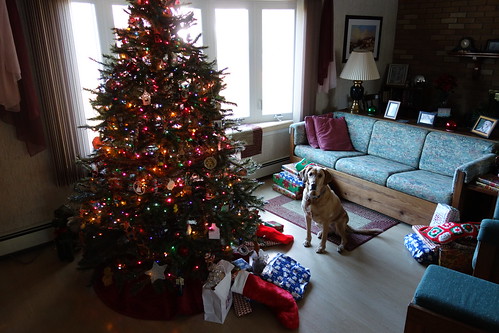“The Perfect Tree” by Henri Marchand

A Christmas tradition here at richardhowe.com is posting Henri Marchand’s “The Perfect Tree” essay which was originally composed for the Sunrise radio program.
We begin the holiday season engaged yet again in a debate of vital importance. It’s an annual and endless argument and we look forward to every December—what qualifies as the perfect Christmas tree? Over the years a variety of false and flawed imposters, each promising no-mess perfection, have been introduced–early plastic trees in distinctly odd greens; the unconventional aluminum specimen illuminated by a 4-color wheel; and, a few years back, the upside down tree. Charlie Brown said it best, “Good grief!” Despite vague threats, claims of greater convenience and calls to “try something different,” over the years we’ve resisted all attempts to go “artificial.”
My wife and I discovered the joy of venturing out to the country to cut our own perfect tree when our children were young. Over the years, as our children have grown up and left home or decided that sleep or term papers were more desirable than putting up with Dad’s all-day search for the holy grail of a Christmas tree, a new tradition was born. I convinced my brother and cousin, both avid hikers, to join me on my annual schlep in search of the elusively perfect tree. And so, the second Saturday of December, following a hearty breakfast at the Owl Diner and with map, tape measure and bow saws in hand, we set off to the wilderness to find the perfect Christmas tree.
My cousin, ever the optimist, sees perfection in every tree. Rick declares the first tree he comes upon a beauty, worthy to cut and hauled home as the centerpiece of this year’s holiday celebration. On the other hand, unless we spend several hours and examine every last tree in the fields, I refuse to acknowledge that we’ve yet found this year’s tannenbaum.
Standing happily by a sapling of a specimen he’ll confidently cry out, “How’s this one?” Seeing me grimace, he’ll ask, slightly indignant and mildly defensive, “What’s wrong with it?”
“Too short,” I’ll offer, or “too tall, crooked trunk, bad side, hole in the middle, no scent, weak branches”—until he gives up and moves on to the next tree, and the next. This goes on until my brother Rene, who, with his pickup truck is the designated driver for this adventure and regards our debate with mock exasperation, makes the sacrilegious suggestion, perfectly timed, that we go to a pre-cut vendor and get the whole thing over with. This starts up another round of spirited disputations and comparisons between fresh-cut and pre-cut trees, needle retention, size, color, selection, safety, and on and on. Thus it goes, back and forth and up and down as we continue to zigzag through the neatly ordered fields of Douglas and Fraser firs, balsams, con-color firs, a few blue spruces. We agree on one thing—scotch pines, natural or not, do not make our list of acceptable varieties and we will bypass them with proper disdain.
There have been some years when we’ve visited nearly half a dozen tree farms, logged at least a hundred miles, and examined several hundred trees in our search for perfection. We’ve slogged through mud, skittered on ice, shivered in unseasonable cold and sweated in unseasonable warmth. All in search of yuletide perfection.
A few years ago a snowstorm made for a particularly seasonal scene and we high-stepped from tree to tree in nearly a foot of snow. Knowing from experience that the snow laden evergreens that looked so Currier and Ivish in the open field were deceiving and might be overwhelming when taken indoors, we shook and brushed off countless boughs in order to properly assess the candidates. Then we had to dig out around the base and account for snow skewered height perspectives. By eleven o’clock we noticed that the snow had become particularly well textured for snowballs. Between neat rows of Fraser firs, a small skirmish broke out.
By noon we were getting hungry and time was running short. With visions of lunch dancing in our heads, the trees began to look better and better. Soon we came upon two that were perfectly and agreeably acceptable. They were cut and carted out of the neatly rowed forest, paid for and carefully placed in my brother’s pickup and taken home, one to my mother’s house and one to mine.
This year family members will gather once again to string the trees with white lights and festoon them with ornaments old and new. And, over toasts and good cheer (and a few more squabbles over credit for selection and the ones that were left behind) all will agree that they are perfect and the best Christmas trees yet.